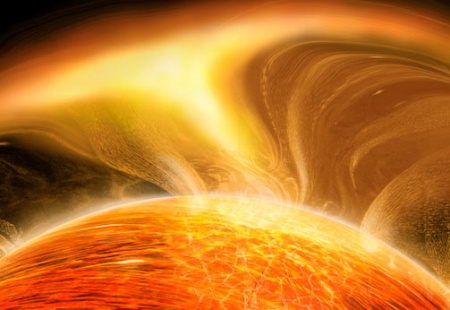Magnetar
A Magnetar is a type of Neutron Star with an extremely powerful magnetic field, the decay of which powers the emission of copious amounts of high-energy electromagnetic radiation, particularly X-Rays and Gamma Rays. The first recorded burst of gamma rays thought to have been from a magnetar was detected on March 5, 1979. During the following decade, the magnetar hypothesis became widely accepted as a likely explanation for Soft Gamma Repeaters (SGRs) and Anomalous X-Ray Pulsars (AXPs). PX 1354 is an example of a magnetar.
Description[edit]
Little is known about the physical structure of a magnetar because they are difficult to study due to inherent dangers from Gamma Ray Bursts. Magnetars are around 20 kilometres (12 mi) in diameter but are more massive than Sol. The density of a magnetar is such that a thimbleful of its material would weigh over 100 million tons on Earth. Magnetars also rotate rapidly, with most magnetars completing a rotation once every 1-10 seconds. The active life of a magnetar is short. Their strong magnetic fields decay after about 10,000 years, after which activity and strong X-ray emission cease. Given the number of magnetars observable today, one estimate puts the number of inactive magnetars in the Milky Way Galaxy at 30 million or more. Quakes triggered on the surface of the magnetar cause great volatility in the star and the magnetic field which encompasses it, often leading to extremely powerful Gamma Ray Flare emissions which have been recorded.
Magnetic Field[edit]
Magnetars are primarily characterized by their extremely powerful magnetic field, which can often reach the order of ten gigateslas. These magnetic fields are hundreds of thousands of times stronger than any man-made magnet, and quadrillions of times more powerful than Earth's magnetic field. They are currently the most magnetic objects ever detected in the universe. A magnetic field of 10 gigateslas is enormous relative to magnetic fields typically encountered on Earth. Earth has a Geomagnetic field of 30–60 microteslas, and a Neodymium-based rare earth magnet has a field of about 1 tesla, with a magnetic energy density of 4.0×105 J/m3. A 10 gigatesla field, by contrast, has an energy density of 4.0×1025 J/m3, with an E/c2 mass density >104 times that of lead. The magnetic field of a magnetar would be lethal even at a distance of 1000 km, tearing tissues due to the Diamagnetism of water. A magnetar can erase credit cards and pull metal objects from your pockets from halfway to the moon. Remarkable things happen within a magnetic field of magnetar strength.
- " X-ray photons readily split in two or merge together. The vacuum itself is polarized, becoming strongly Birefringent, like a calcite crystal. Atoms are deformed into long cylinders thinner than the quantum-relativistic Wavelength of an electron."
In a field of about 105 teslas atomic orbitals deform into rod shapes. At 1010 teslas, a hydrogen atom becomes a spindle 200 times narrower than its normal diameter.
Formation[edit]
When, in a Supernova, a star collapses to a neutron star, its magnetic field increases dramatically in strength. Halving a linear dimension increases the magnetic field fourfold. Duncan and Thompson calculated that the magnetic field of a neutron star, normally an already enormous 108 Teslas could, through the Dynamo Mechanism, grow even larger, to more than 1011 teslas (or 1015 Gauss). The result is a magnetar. The supernova might lose 10% of its mass in the explosion. In order for such large stars (10 to 30 solar masses) not to collapse directly into a Black Hole, they have to shed a larger proportion of their mass— perhaps another 80%. It is estimated that about one in ten supernova explosions results in a magnetar rather than a more standard neutron star or Pulsar.
